Friction: surface resistance to relative motion. In other words, the act of slowing down an action due to unnecessary contact. One of mankind’s greatest desires is to eliminate unnecessary interactions that slow us down and prevent us from maximising our personal utilisation. This is the driving principal behind the explosion in the online sales industry.
E-commerce has created a nearly frictionless shopping experience for its customers and rewards its loyalists with more time to do the activities they enjoy. The biggest cost to the consumer has never been the number at the bottom of the receipt; it has always been the unnecessary time wasted to purchase our everyday items. The dramatic impact online shopping has had on the economy has resulted in massive retail store closings and record setting industrial development worldwide. As the demand for industrial real estate continues to sky rocket, some industry experts have deemed this transition the “retail apocalypse” and that we could experience the complete demise of the retail industry in the near future.
Yet, A recent report released by the IHL Group, a global research and advisory firm specialising in technologies for the retail and hospitality industries, shows net chain-store openings across the United States have been strong in the US and are forecasted to increase by 35% in 2018 [1]. At the same time, 42% of current retailers have increased year-over-year net sales versus 15% who have experienced a decline (the remaining have experienced unchanged net sales). So with all the recent success of the e-commerce industry, why have traditional retailers also experienced success? Very simple, many people still enjoy traditional shopping and interacting with the local community.
The report also explained that 16 chain-retailers have accounted for 48.5% of the total number of store closings in recent years. Together, Radio Shack, Payless Shoes, Rue21, Ascena Retail, and Sears account for 28.1% of the store closings. These household brand names are disappearing for two reasons; 1) they offer goods that can easily be ordered online without the in-store hassle and 2) they deliver absolutely no memorable shopping experience that offsets the negative utility of lost time. In comparison, convenience store retailers, modern grocery outlets, and table service and fast-casual restaurants are opening in droves. Greg Buzek, President of IHL Group, explains that the retailers who are incorporating technology to enhance customer experience are the ones who are currently succeeding.

Mixed use retail and leisure: What happens next? – White Paper
In a recent presentation by Amazon’s Head of Global Supply Chain for Amazon Prime Now, Chris Peyre, it was emphasised that Amazon’s overall success is largely attributed to its overwhelming dedication to delivering a “frictionless” shopping experience to its customers [2]. Amazon is without question the biggest disrupter of the retail industry in recent years, yet they are also investing heavily into their brick and mortar retail business. Why? Although e-commerce is growing at an astounding 15% year over year, it still only accounts for approximately 12% of total retail sales, excluding fuel and car sales [3]. That means 88% of retail sales still occur at brick and mortal stores, which gave Amazon CEO Jeff Bezos an idea that will completely revolutionise the in-person shopping experience. Behold, Amazon Go.
Amazon Go has one goal in mind: provide customers with a shopping experience that includes no check out process. Mr. Peyre gave the audience an awe-inspiring look into Amazon’s new neighborhood market venture and it will simply change everything. Amazon Go relies on a new experience they call Just Walk Out technology, which incorporates the latest in computer and sensor technologies to create a digital shopping cart for customers as they shop. It will go something like this: you scan your smartphone as you walk into the store, you grab the items you need, and simply walk out of the store. Done. As you walk out, Amazon charges your digital wallet for the items you purchased. Change your mind on item after you already placed it in your bag? No problem, just put it back on the shelf and the sensor technology will notice your return and the item will be removed from your digital shopping cart. Opps, you just realised you forgot a crucial ingredient for a new recipe you are trying that night… No worries, just walk back in, grab what you forgot, and walk back out. No more dealing with a double check out with a melting pint of Ben & Jerry’s in the car. Welcome to the future of neighborhood shopping.
Amazon Go currently has one location on 7th Avenue in Seattle, WA, however it is still in beta testing and is currently only open to Amazon employees. That doesn’t mean we can’t be excited for what is to come. Listening to Peyre’s speech, one couldn’t help but imagine all the possible applications for this technology. Checkout-less convenience stores, grocery markets, clothing outlets, coffee shops, and so on. My personal favorite: scan into a restaurant, menu is sent to your phone, sit down, order on your phone, food is brought to you, and leave when you are done.
Consumer technologies such as this are remarkably exciting and as it continues to develop and advance, so will the consumer shopping experience. Although e-commerce is expanding at a remarkable rate, it is likely to taper off at some point. The question of when that will occur remains, however. Currently, e-commerce is ideal for industries that provide non-perishable goods, but with companies like Amazon purchasing grocery retailers like Whole Foods, it seems as if the industry is destined to compete in that arena very soon. I personally see objection to that belief for a few reasons:
- The recent “organic” and “farm-to-table” movements prove that consumers are extremely picky about the quality of the fresh food they purchase and where is comes from
- Nothing will replace the “hold in your hand” experience grocery stores currently provide for purchasing fresh produce
- How do you itemise individual fruits and vegetables so that customers can’t exchange week-old items for fresh ones? Barcode stickers can easily be interchanged and sealable plastic can damage fruit and vegetables. I foresee many logistical and consumer honesty issues with perishable food delivery
This all means that retailers will need to continue to adapt to consumer demands and adopt new ways to enhance the customer shopping experience in order to remain relevant.
Sources:
[1] http://www.ihlservices.com/news/analyst-corner/2017/08/retailers-opening-over-4000-stores-in-2017/
[2] Chris Peyre Amazon Speech
[3] https://www.census.gov/retail/mrts/www/data/pdf/ec_current.pdf
Top photo © deepblue4you/GettyImages




